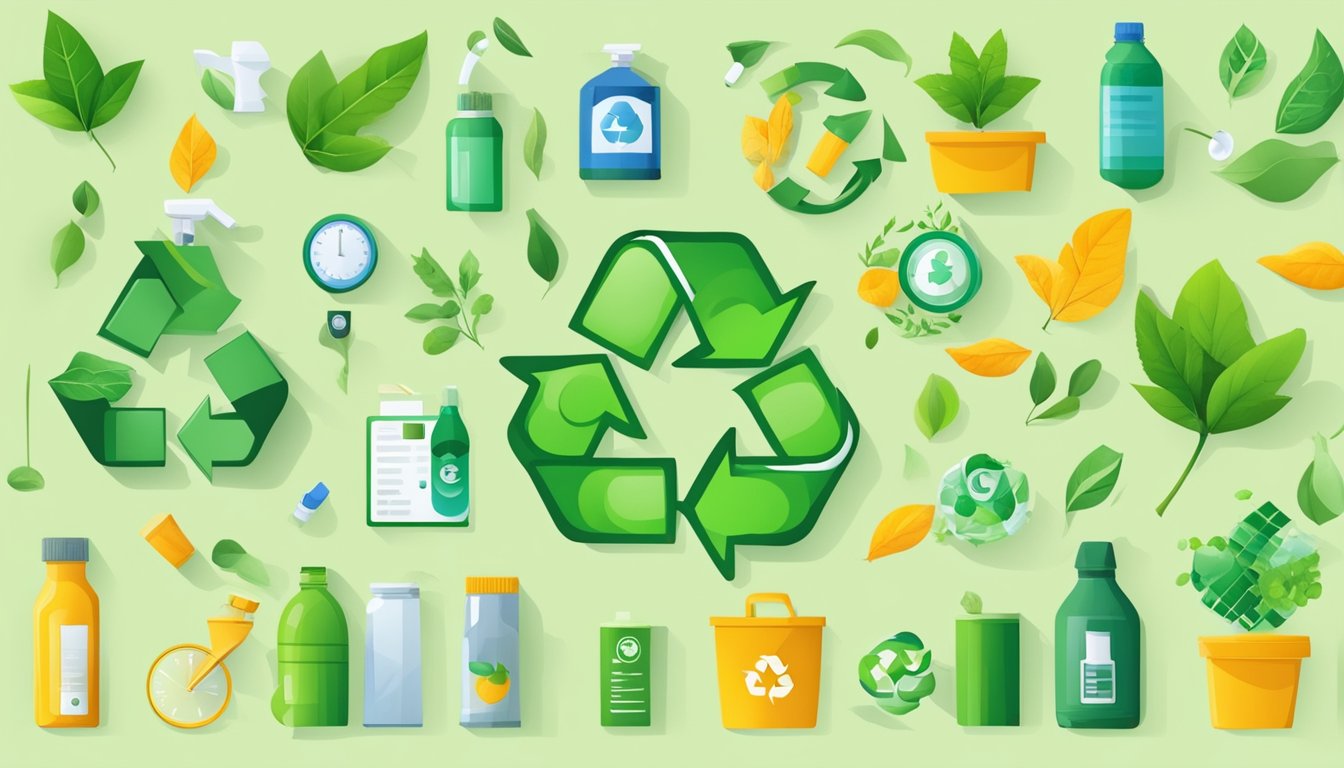The rise of eco-friendly products has marked a significant shift in consumer behaviour. This reflects an increasing environmental awareness and a growing commitment to sustainability.
These products are developed with both the environment and human health in mind. They aim to reduce the negative impact on the planet while promoting well-being.
From biodegradable materials to non-toxic chemical formulations, the range of goods classified as sustainable is diverse. But they all share a common goal: to offer consumers a means to make more responsible lifestyle choices every day.
Choosing eco-friendly options can have a positive effect on personal health. Reduced exposure to harmful chemicals found in many conventional products can lower the risk of developing certain health issues.
Furthermore, the production processes for green products often consume less energy and produce fewer pollutants. This holistic approach, combining personal health benefits with wider ecological advantages, underpins the rationale behind their growing popularity in the marketplace.
Key Takeaways
- Eco-friendly products are designed to be better for the environment and can improve personal health.
- The production and use of sustainable goods contribute to environmental conservation efforts.
- The demand for green products is shaping consumer behaviour and market trends toward greater sustainability.
Defining Eco-Friendly Products
In this section, one will explore what constitutes eco-friendly products, their characteristics, and how they differ from conventional goods. It’s essential to understand these elements to appreciate the positive impact they have on health and the environment.
Characteristics of Green Products
Eco-friendly products, also known as green products, demonstrate sustainability. They are typically made from renewable resources and are designed with environmental consciousness at the forefront.
They are also biodegradable, meaning they break down naturally and do not persist in the environment, causing harm. Moreover, green products often have a reduced carbon footprint during their lifecycle, which includes production, usage, and disposal.
The use of non-toxic or minimal toxic materials is also a crucial characteristic, ensuring that they are safer for both the environment and personal health. Products may also carry certifications from recognised bodies that validate their eco-friendly credentials.
Comparing Traditional and Eco-Friendly Products
When comparing traditional products to their eco-friendly counterparts, one must consider the long-term environmental impact of their production and use. Traditional products often:
- Use non-renewable resources, contributing to depletion
- Produce higher levels of pollutants during manufacturing
- Generate waste that is not biodegradable
Eco-friendly products, on the other hand, are designed with sustainability in mind:
- They utilise renewable resources to reduce depletion
- Aim to minimise pollution throughout their lifecycle
- Are crafted to be recyclable or compostable, promoting a circular economy
Consequently, they contribute to a reduced environmental footprint and support the growth of consumer environmental knowledge and responsible consumption habits.
Impact on Personal Health
Choosing eco-friendly products has a tangible impact on personal health by reducing interaction with hazardous chemicals and enhancing the benefits obtained from natural and organic options.
Reducing Exposure to Harsh Chemicals
Eco-friendly cleaning products play a significant role in improving indoor air quality by minimising the release of volatile organic compounds (VOCs) which are often found in traditional cleaners. These VOCs can contribute to chronic respiratory problems, allergic reactions, and headaches. By opting for products without harsh chemicals, individuals protect themselves from these potential health risks.
Benefits of Natural Ingredients and Organic Food
Incorporating natural ingredients in personal care products can lead to a lower risk of skin irritation and allergies. Products like soaps and shampoos made with plant-based components support skin health and are gentler on the body.
Meanwhile, organic food, free from synthetic fertilisers and pesticides, is associated with a higher nutrient profile, including essential vitamins, and can support overall health and well-being.
Environmental Benefits and Conservation
When considering eco-friendly products, their impact often extends far beyond personal health. These products play a crucial role in environmental conservation and the mitigation of detrimental pollution.
Mitigating Pollution and Protecting Marine Life
Eco-friendly products often avoid harmful chemicals that can lead to soil and water pollution. They also reduce the amount of plastic waste that ends up in oceans, threatening marine life.
For instance, biodegradable packaging decomposes naturally, posing less of a threat to sea creatures who might otherwise ingest or become entangled in plastic debris.
Sustainable Agriculture and Organic Farming
Organic farming reduces the reliance on chemical pesticides and fertilisers, leading to less soil and water contamination. It also supports a sustainable agriculture system that conserves water and ensures soil health.
Organic cultivation is beneficial for the environment by fostering biodiversity and reducing greenhouse gas emissions associated with industrial farming.
Reducing Carbon Footprint through Sustainable Practices
Adopting sustainable practices like using products made from recycled materials or sourced from renewable resources directly contributes to decreasing the carbon footprint of individuals and businesses.
Efforts such as implementing circular economy principles and prioritising renewable energy can significantly lower environmental degradation and foster environmental conservation.
Consumer Behaviour and Market Trends
In today’s market, consumer behaviour is increasingly influenced by environmental consciousness, which in turn shapes the trends in green marketing and brand perception.
Influence of Environmental Awareness on Purchase Intention
Environmental awareness is a driving force behind the rise in green purchase intentions. Consumers with high environmental consciousness are more likely to be persuaded by green marketing efforts that highlight eco-friendliness as a key value proposition.
They often evaluate the green perceived value and green perceived risk associated with products, which play a crucial role in their decision-making process.
Research employing structural equation modelling has demonstrated a direct correlation between environmental attitudes and consumers’ willingness to invest in eco-friendly products.
Gender and Demographics as Moderating Factors
Gender moderation effect plays a significant role in green consumerism, with studies suggesting that women may exhibit stronger environmental attitudes and purchase intentions towards eco-friendly products.
Demographics, including age and education level, further influence green consumption behaviours.
Market research has revealed that younger, more educated demographics are often at the forefront of eco-conscious buying.
Evolution of Green Marketing and Brand Perception
The concept of green marketing has evolved significantly, with eco-friendly brands increasingly focusing on building green trust through transparency and environmental advocacy.
Green consumers tend to show loyalty towards brands that consistently demonstrate an authentic commitment to sustainability.
The shift in consumer values has prompted companies to adopt more nuanced marketing strategies, emphasising green credentials and fostering a positive brand perception aligned with environmental consciousness.
Green Innovations and Technology
In the pursuit of sustainability, green innovations and technology are playing pivotal roles in the way products are developed, used, and managed through their lifecycle. They’re not only transforming industries but also pushing the boundaries of environmental responsibility.
Promoting Renewable Energy and Electric Vehicles
Renewable energy sources, such as wind and solar power, are integral to green innovations. Their advancement has led to more accessible and efficient technologies that feed into the power grids with less environmental impact.
These developments have progressively paved the way for a cleaner transport sector, with electric vehicles now seen as the future of eco-friendly transportation.
The adoption of EVs dramatically reduces reliance on fossil fuels, leading to diminished air pollution and a significant cut in greenhouse emissions.
Green Product Distribution and Sustainable Packaging
Green product distribution systems are another crucial aspect, focusing on eco-friendly practices that minimise carbon footprints.
Companies are increasingly held accountable for their social responsibility to invest in more efficient logistics.
Additionally, the introduction of sustainable packaging made from recyclable materials is drastically reducing waste. It is evident that businesses employing these methods are notably contributing towards sustainable development and the availability of environmentally friendly products on a wider scale.
Responsibility and Policy
In the pursuit of sustainable development, companies and governments play pivotal roles. Through Corporate Social Responsibility and Fair Trade initiatives, companies demonstrate their commitment to ethical practices, whilst government regulations enforce environmental stewardship.
Corporate Social Responsibility and Fair Trade
Companies today are expected to go beyond mere compliance with laws; they are now seen as vital contributors to sustainable development.
A company’s commitment to Corporate Social Responsibility (CSR) includes integrating social and environmental concerns in their business operations. This approach benefits both the society and the company’s own sustainability.
For example, eco-friendly products are often the outcome of fair trade practices, which ensure that producers in developing countries obtain a fair share of profits, leading to improved social and economic outcomes.
Examples of CSR in action include using sustainable materials in their products, reducing emissions in manufacturing, and engaging in fair trade.
Fair Trade is not just a certification or a label; it’s a way of doing business that pushes for better wages and working conditions for farmers and producers.
Government Regulations and Environmental Stewardship
On the governmental side, regulations serve as a backbone for environmental stewardship.
Policies enacted by the government can set strict guidelines for companies to follow, such as limits on pollution, requirements for waste management, and incentives for renewable energy use.
These regulations are essential to curtail environmental problems and promote a healthy ecosystem.
The government may also provide support for residential uptake of eco-friendly products, by subsidising costs or offering tax incentives.
Regulations can also cover a broad spectrum of environmental issues, ranging from local waste management to international agreements on climate change. By doing so, they ensure that social and corporate activities align with the broader goal of environmental conservation.
Lifestyle and Daily Choices
The integration of eco-friendly habits into daily routines can significantly impact sustainability and health.
From the personal care products one selects to the commitment to regular exercise, these daily choices collectively contribute to a healthier individual and planet.
Adopting Eco-Friendly Habits in Personal Care and Exercise
One can start their day by choosing eco-friendly personal care products, such as shampoos and soaps that are free from harmful chemicals and packaged in biodegradable materials.
Likewise, incorporating sustainable fitness gear—which might include items made from recycled materials—into one’s exercise regimen doesn’t just reduce the environmental footprint but often supports better overall physical health.
Role of Consumers in Recycling Behaviour and Reducing Solid Waste
Consumers have considerable control over their recycling behaviour and can help lessen solid waste generation:
- At Home: They can separate recyclables from trash, contributing to a reduction in landfill waste.
- Shopping Habits: Opting for products with minimal packaging or made from recycled materials can decrease one’s impact significantly.
These proactive habits contribute to mitigating environmental problems while enabling a more sustainable lifestyle.
Frequently Asked Questions
This section delves into common inquiries regarding the health benefits and impacts of eco-friendly products, supported by recent research and environmental considerations.
What are the potential health benefits of using eco-friendly products?
Using eco-friendly products can lead to decreased exposure to harmful chemicals, often resulting in improvements in skin conditions and respiratory health.
Individuals may experience fewer allergies and a reduced risk of chemical-related illnesses.
How do eco-friendly products contribute to a healthier environment?
Products that are environmentally friendly typically have a lower carbon footprint and are made without harmful pesticides or chemicals. This means fewer toxins are released into the air and water, helping to preserve ecosystems and promote biodiversity.
Could there be any negative health effects associated with eco-friendly products?
Although rare, it’s possible for eco-friendly products to have unintended negative health effects if they are not properly regulated or if individuals have specific allergies to natural ingredients.
What have recent studies concluded about the health impacts of eco-friendly goods?
Recent studies suggest that the use of eco-friendly goods can reduce health risks associated with exposure to toxic substances found in conventional products, supporting their positive impact on overall well-being.
How does the production of eco-friendly items compare in safety to traditional products?
The production processes for eco-friendly items generally use safer, non-toxic materials and follow regulations that aim to protect workers’ health, making them safer compared to conventional product manufacturing.
What are the long-term health implications of switching to environmentally friendly products?
Consumers who switch to environmentally friendly products can expect a decrease in health risks related to toxin exposure.
Communities may benefit from improved environmental quality, which supports public health.



